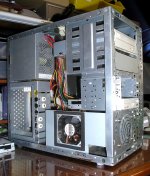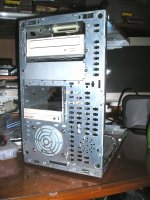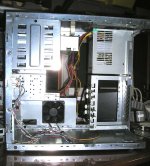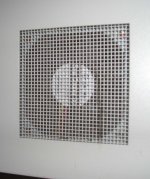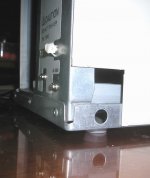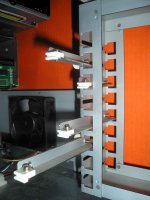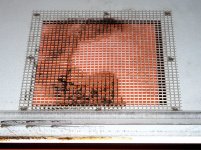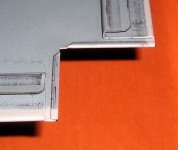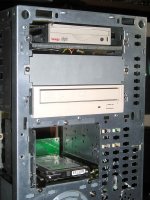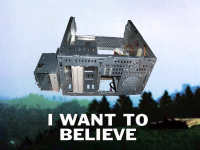I realize this started out as a pretty much "Standard ATX case," but there are several things at odds with it being a production machine as pictured in the bezel removal diagram on its @$$end.
Uhm, what? Are you saying the diagram is wrong, or the diagram is something that would appear on a prototype, not a production case, what?
Looking at the pictures again I'm more and more certain I've dealt with this exact case before. It had a U-shaped top, and they "cleverly" hid the screws to remove the top behind it. Thus to open it you had to yank the bezel off. I remember people getting really confused because they were used to having the screws to get the top off in the back and the bezel firmly screwed in place from the inside, so by all appearances these cases would appear hermetically sealed if you didn't know the trick. (Not every reseller of these things was nice enough to put the sticker on the back.)
I checked out the exploded diagrams of the 8600/9600 cases in the Service Source while I was at work.
What does that have to do with anything? The tray might be from a 9xxx, but the case has *nothing* to do with the tray. Again, look, it doesn't fit the spacing of the bays properly.
Have they got a fan mounted to the left hand... (snip)...The hole on the case cover matching up with the fan is professionally done, but by no means a standard feature.
This has all the hallmarks of a short production run of an oddly modified stock case.
Actually, what I suspect happened here was that this case chassis, the design of which which I think dates from around 1998-1999, was updated to "relocate" that front fan to face to the side with that added-on bracket but they never updated the front stamping to get rid of the dome. Side-facing fans started being a "thing" sometime around 2001-2002 because of the sheer amount of heat coming off the 1Ghz+ AMD and Pentium 4 CPUs of that era was significantly more than that coming off 1999-era chips. Plus, you know, someone decided it looked cool. Undoubtedly the case skins were also updated to include some stamped/milled slots that matched up with this. (Or possibly they just cut a hole and screwed a grill over it.)
1997 - 9600/8600 Released & Apple halts all CHRP licensing.
*Why* would an IBM case have a specific Apple drive tray in it? That isn't a "prototype" part, I was able to search it from the part number stamped on it.
Ten years later I found this oddity in a thrift shop just outside RTP.
Heaven knows there weren't any other sources of junk computers in RTP besides SUPER SECRET laboratories.
BTW, that Apple drive mounting plate seems to be made to fit this case
No, it's not. It happens to be the right width to wedge in there, but it's not made to fit that case by any stretch of the imagination. Here, I've annotated your picture to show what the problem is:

It's simply *not* the right part. The case has 3 drive bays; you screwed rails to the devices, and the rails had screw-ears which let you secure the device to the case. That mismatched tray turns 3 drive bays into *one* as mounted: It pushes the CD-ROM drive halfway into the bay above it, and the lip on the bottom edge of the tray means even if you had another one you wouldn't be able to put another regular-height device below it either. (You could stick one in there if you had the rails, or just chuck one in and let it lie on the bottom of the cage, but then there will be an obvious gap between it and the device above. Oh, yeah, I'm sure that's for "cooling", right?)
it puts the Optical drive bay and the tape/zip bay just about where they wound up in the 9600/8600. Spacing is wrong for the floppy up top...
Sigh. The floppy goes in the 3 1/2 inch bay. There's a drawing of the bezel on the sticker that shows what it looked like: 3 exposed 5 1/4 inch bays, 2 exposed 3 1/2 inch slots, the bottom 3 1/2 device was obscured.
Seriously, I *swear* I had this exact case. If you googled *enough* you could find a picture of it, the problem is that no one *cares* about 2000-vintage generic PCs. It's a dime-a-dozen (but well built) OEM PC chassis, *nothing* special about it.
Not saying it's an Apple prototype, not even saying it's an IBM CHRP prototype, just saying that when I look at it now, it looks like A prototype box . . .. . . and that's alot of coinkidinks.
"It came from a thift shop in a town where *maybe* there were prototype boxes floating around 10 years before I got it and, uhm, if I squint my eyes the proportions sort of remind me of the Power Mac 8600 even though it's actually wrong in every conceivable detail. By jove, PROTOTYPE!"



